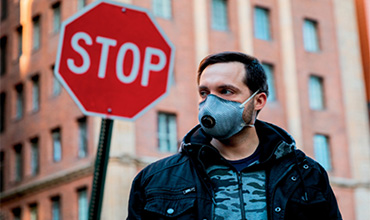


Liu Kai (School of Architecture of Southeast University)
Shi Yu (School of Architecture of Southeast University)
In January 2020, COVID-19 broke out in Wuhan and swept across China. The speed at which it spread, the infections it caused, and the difficulty in preventing and controlling it, went far beyond what people could possibly imagine. To curb the spread of the epidemic, China mobilized people from all walks of life in a concerted effort to combat it. Governments and organizations from the rest of the world and overseas Chinese nationals also offered donations and supplies to China in solidarity with the Chinese people to confront the epidemic. As of mid-March 2020, new reported cases of COVID-19 have fallen continuously in China, portending a victory in the battle against COVID-19. But at the same time, COVID-19 cases surged in the rest of the world. On March 12th, the World Health Organization (WHO) declared the novel coronavirus outbreak a global pandemic. On March 19th, the total confirmed cases of COVID-19 in the world except China passed 130,000, with the epicenter shifting from Asia to Europe and the US and more cases appearing in Africa and the Middle East. As COVID-19 spreads and transmits around the world threatening the entire human race, how to effectively prevent and control it has become a major problem that requires shared efforts of all countries to tackle.
Cities bear the brunt of epidemic transmission
According to epidemiological research, infectious diseases usually transmit through food and water, res piratory droplets, insects, and people-to-people contact. Large-scale migration, frequent contact, and a high degree of spatial proximity, have often made cities, which are the specific space for highly concentrated population, the epicenter of the outbreak and transmission of infectious diseases. For example, Athens, the ancient Greek city-state and the crown jewels of the world’s urban development history, lost almost half of its population to a plague; and cholera, an infectious disease still required by the WHO to be quarantined, was just locally transmitted in India and Bangladesh prior to the 19th century, but soon started to get prevalent across the globe with the emergence of new industrial cities after the 19th century.
As central cities and city clusters have become the major spatial forms to incorporate elements of development, the emergence of megacities and explosive growth of cities have certainly exacerbated the risks of the outbreak of infectious diseases. And with deeper global integration, urban networks and transport networks have been formed around the world, and the global population has been migrating much more frequently and on a dramatically increased scale, making it possible for infectious diseases to break out worldwide on an unprecedented scale and at an unprecedented speed. For example, SARS, which broke out in 2003, spread to 32 countries and regions, with around 8,400 confirmed cases worldwide and a global death toll of about 900; H1N1 that appeared in 2009 quickly spread to over 200 countries in a very short period of time, causing more than 20 million infections and over 10,000 fatalities. So it’s easy to see urban prevention and control of infectious diseases is key to mankind’s fight against their spread.

Global cooperation for win-win outcomes Photo: geralt
Cities still play a crucial part in epidemic prevention and control
Countries have all responded to the call of the WHO by making interventions at the national level to prevent and control COVID-19. In addition to testing and treatment, they have made urban management and control an important part of their epidemic prevention and control endeavour. The urban management and control measures taken by countries at present can be classified into three types.
First, launching institutional emergency response to provide support for epidemic prevention and control. For example, South Korea raised its COVID-19 alert level to the highest on February 23rd 2020 and again declared “war” on the disease nationwide on March 3rd, placing all government agencies on a 24-hour emergency footing; and Japan passed a bill revising the Act on Special Measures for Pandemic Influenza and New Infectious Diseases Preparedness and Response on March 13th, allowing the country to quickly go into a state of emergency and take any legally enforceable measures should COVID-19 spread fast across the country. Second, controlling urban migration to cut off transmission routes of the disease. The authorities in San Francisco declared a lockdown expected to go into effect from midnight March 16th and required its citizens to stay at home except for essential needs, where pharmacies, grocery stores, banks, gas stations, and basic public services would remain open, pubs and gyms would close temporarily, and restaurants would only provide takeout or delivery service; and Spain also went into lockdown on March 13th, where all of its people had to stay at home unless they had to buy food, go to hospital, or work, non-essential public places, such as commercial districts, museums, libraries, and restaurants, had to close, and traffic flows on public transit and private transport nationwide were restricted. Third, increasing urban medical facilities and supplies to treat and quarantine patients as quickly as possible. For example, in Iranian cities that were hit hardest by COVID-19, such as Tehran, Qom, and Yazd, local governments built 14 makeshift hospitals to treat COVID-19 patients in venues such as exhibition centers, providing over 2,000 beds; and Italy, whose hospitals had been short of beds and inundated with patients, managed to set up more than 300 makeshift inflatable tents outside of over 31 hospitals for shunting, screening, diagnosis, and quarantine.
The inherent conflict between urban development and epidemic transmission
A look back on the urban development history of several thousand years reveals that it’s always been a priority for cities, which have long been hit hardest by natural disasters or public health emergencies, to enhance their resistance. As early as the 15 century, the outbreak of the Black Death triggered a joint concern among European cities for their infrastructure building and environmental governance and helped push the development of their water supply and drainage as well as waste disposal facilities. And as recently as the 1980s, the WHO proposed a global action strategy on healthy cities that stressed the need to put people’s health at the center, build a social environment conducive to people’s health and work from the perspective of urban planning, building, and management, and call on cities across the globe to develop healthy city plans and health management laws and regulations, adopt antipollution measures, and encourage citizens to participate in urban health development in a bid to make cities more resilient and better capable of responding to public health safety incidents. The strategy was recognized by the US, Europe, Japan, Singapore, China, and Australia, etc., which all get involved to implement it, and has evolved into an international city building campaign.
Cities across the world have done a lot of work in public health emergency response, in particular prevention and control of infectious diseases, but the global spread of COVID-19 and its prevention and control worldwide have indicated that both developing countries with weaker medical systems and the developed world with better urban governance capacity and systems have been crippled by the epidemic. The reason is that population concentration in cities is inherently in conflict with transmission of infectious diseases via the spatial neighborhood effect. From the perspective of development, building cities is aimed at driving reasonable flow and efficient aggregation of various elements, attracting huge capital and human inflow, expanding the scale and aggregation effects, offering more capital return, and providing more and better job opportunities, to create a positive cycle. From the perspective of prevention and control of infectious diseases, overpopulation, heterogenization and diversification of health conditions, and frequent exchanges and contacts, coupled with poor governance, outdated development perceptions, and deficient governance systems in some cities, have made the inherent conflict seemingly irreconcilable.
Meet challenges head-on with a shared urban response
How to reconcile urban development with transmission of infectious diseases, guide cities to build systems for preventing and controlling infectious diseases, and make cities better capable of responding to public health emergencies, is something that no city planner can possibly shun away from.
In the mid 18th century when smallpox was raging, English doctor Edward Jenner risked contracting the disease to develop the smallpox vaccination that finally put an end to the suffering of mankind, marking not only the official appearance of a vaccine but the start to apply science and technology to proactive prevention and control of infectious diseases. Today, in the face of the outbreak of a global pandemic, it is important to allow urban space allocation and urban building management to come into play for intervention, build more urban infrastructure and public service facilities, and improve public service systems. Also, in addition to medical and supply facilities, it’s imperative to pay attention to and restrict urban over-congestion and ensure adequate public space in parks and squares. And it’s necessary to take precautions by building urban emergency response systems for preventing and controlling infectious diseases, especially those for providing space for emergency use.
We ought to respect the law of urban development and have a moderate control of the scale of urban development, rather than solely focus on growth. In a world where we all share the weal and woe, no country can stand alone in the fight against viruses. Cities across the globe shall establish systems for disease information sharing and emergency coordination on a broader scale, increase assistance and cooperation in treatment and vaccine development, push for building a community of shared future for mankind, and protect our common interests and well-being.